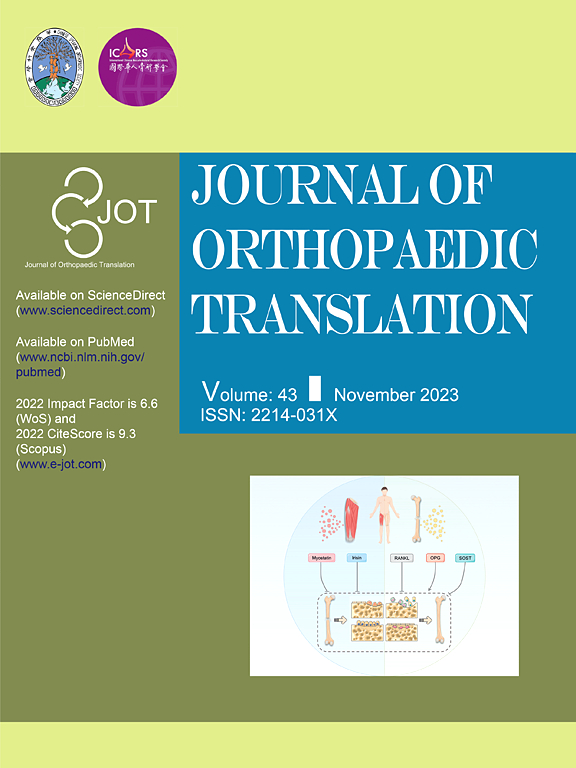Piezoelectric biomaterials for providing electrical stimulation in bone tissue engineering: Barium titanate
IF 5.9
1区 医学
Q1 ORTHOPEDICS
引用次数: 0
Abstract
With the increasing clinical demand for orthopedic implants, bone tissue engineering based on a variety of bioactive materials has shown promising applications in bone repair. And various physiological cues, such as mechanical, electrical, and magnetic stimulation, can influence cell fate and participate in bone regeneration. Natural bone has a piezoelectric effect due to the non-centrosymmetric nature of collagen, which can aid in cell adhesion, proliferation and differentiation, and bone growth by converting mechanical stimuli into electrical stimuli. Piezoelectric materials have the same piezoelectric effect as human bone, and they are able to deform in response to physiological movement, thus providing electrical stimulation to cells or damaged tissue without the need for an external power source. Among them, Barium titanate (BaTiO3) is widely used in tumor therapy, tissue engineering, health detection and drug delivery because of its good biocompatibility, low cytotoxicity and good piezoelectric properties. This review describes the piezoelectric effect of natural bone and the characteristics of various types of piezoelectric materials, from the synthesis and physicochemical characteristics of BaTiO3 and its application in biomedicine. And it highlights the great potential of BaTiO3 as piezoelectric biomaterials in the field of bone tissue engineering in anticipation of providing new ideas and opportunities for researchers.
The translational potential of this article: This review systematically discusses barium titanate, a bioactive material that can mimic the piezoelectric effect of natural bone tissue, which can intervene in the regenerative repair of bone by providing a sustained electrical microenvironment for bone repair scaffolds. This may help to solve the current problem of poor osteogenic properties of bioactive materials by utilizing barium titanate.

在骨组织工程中提供电刺激的压电生物材料:钛酸钡
随着临床对骨科植入物需求的不断增加,以多种生物活性材料为基础的骨组织工程在骨修复中显示出广阔的应用前景。各种生理因素,如机械、电和磁刺激,可以影响细胞的命运并参与骨再生。由于胶原蛋白的非中心对称性质,天然骨具有压电效应,它可以通过将机械刺激转化为电刺激来帮助细胞粘附、增殖和分化以及骨骼生长。压电材料具有与人体骨骼相同的压电效应,它们能够根据生理运动而变形,从而在不需要外部电源的情况下为细胞或受损组织提供电刺激。其中,钛酸钡(BaTiO3)因其良好的生物相容性、低细胞毒性和良好的压电性能,在肿瘤治疗、组织工程、健康检测和药物递送等领域得到广泛应用。本文从BaTiO3的合成、理化特性及其在生物医学中的应用等方面,综述了天然骨的压电效应以及各类压电材料的特点。强调了BaTiO3作为压电生物材料在骨组织工程领域的巨大潜力,有望为研究人员提供新的思路和机会。本文的翻译潜力:本文系统地讨论了钛酸钡,一种可以模拟天然骨组织压电效应的生物活性材料,它可以通过为骨修复支架提供持续的电微环境来干预骨的再生修复。这可能有助于解决目前生物活性材料利用钛酸钡成骨性能差的问题。
本文章由计算机程序翻译,如有差异,请以英文原文为准。
求助全文
约1分钟内获得全文
求助全文
来源期刊

Journal of Orthopaedic Translation
Medicine-Orthopedics and Sports Medicine
CiteScore
11.80
自引率
13.60%
发文量
91
审稿时长
29 days
期刊介绍:
The Journal of Orthopaedic Translation (JOT) is the official peer-reviewed, open access journal of the Chinese Speaking Orthopaedic Society (CSOS) and the International Chinese Musculoskeletal Research Society (ICMRS). It is published quarterly, in January, April, July and October, by Elsevier.
 求助内容:
求助内容: 应助结果提醒方式:
应助结果提醒方式:


